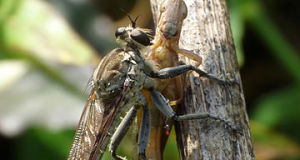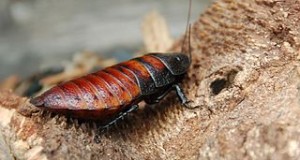Today I’ll introduce a member of a group of insects that have long fascinated me – the stick insects, or walking sticks. Several of the over 2,700 described species are well established in captivity, especially among European hobbyists. They are growing in popularity here in the USA also, most commonly, I’ve noticed, among reptile and amphibian keepers. (Note: laws governing the keeping of insects vary from country to country and state to state; please check those applicable to you before purchasing insect pets). 
Ants as Babysitters
Today’s insect hails from Australia and New Guinea (as do most truly bizarre creatures!). I’ll cover the husbandry of the giant spiny stick insect in the future…for now I’d like to provide you with a look at its most incredible reproductive strategy.
Female giant spiny stick insects lay approximately 12 eggs at a time, and may produce up to 1,000 or more during their lives. They fall to the ground after being quite forcibly ejected by the cloaca.
The eggs resemble seeds and are tipped with a structure known as a capitulum. The captiulum’s collar is a favored food of ants of the genus Leptomyrmex. The ants carry the eggs into their nest, where the collar is eaten. The stick insect’s eggs are then discarded in the ant colony’s underground rubbish pile, where, protected from predators and the fires that regularly ravage the forests above, they develop.
Tricking the Ants
The walking stick nymphs mimic Leptomyrmex ants in color (black body, red head) and move about in a rapid, frantic manner as do the ants (adult stick insects are slow moving). They also curl their abdomens up over the body, in the manner of their ant hosts.
Upon leaving the ant nest the stick insects moult, assume the adult body form and coloration, and climb into trees to live. All walking sticks undergo incomplete, or hemimetabolous, metamorphosis – there is no pupae stage.
A Variable Path to Reproduction
This species may reproduce either sexually or by parthenogenesis. Eggs produced via mating hatch in approximately 4 months, while those produced via parthenogenesis may take 9 months or more to hatch.
Strange, even for an insect, don’t you think? I’m always interested to hear about unique survival strategies…please write in with your own favorites and I’ll share them in future articles.
You can read more about this and related stick insects at:
http://www.novelguide.com/a/discover/grze_03/grze_03_00194.html#Macleays_spectre
Image referenced from Wikipedia and originally posted by Stephan M. Hohne
http://en.wikipedia.org/wiki/Image:Extatosoma_tiaratum_114.jpg
 That Reptile Blog – Reptile, Amphibian and Exotic Pet Care and Information
That Reptile Blog – Reptile, Amphibian and Exotic Pet Care and Information



My understanding of these guys is that they are illegal in the US without a permit from the USDA, and thus out of reach of private hobbyists. Any chance that will change? A lot of them are still being passed around “underground” here, I understand they used to be quite popular, as they still are in Europe and some other places.
Hello, Joseph, Frank Indiviglio here. Thanks for your comment.
As of now, the USDA requires permits for all non-native insects and for all herbivorous non-insect invertebrates, i.e. Australian stick insects, Asian mantids and African millipedes are covered, Vietnamese centipedes are not. Technically, even the hissing roaches that are in so many classrooms throughout the country are included in the permit requirements (in fact, just this week Florida Fish and Game began an investigation into the various species of roaches being sold instate). All sorts of insects are sold openly without permits, and have been for decades, so how all will play out is anyone’s guess…actually, now that I think of it, even the common pet trade house cricket and super mealworms are not native…
I’ve been through the permitting process as few times, and it is quite tedious. Permits have been granted to private individuals…usually long-established importers with a significant collection. In the past, exceptions had been granted for those seeking to keep male invertebrates only, but I’m not sure if this still being done.
Best regards, Frank Indiviglio.